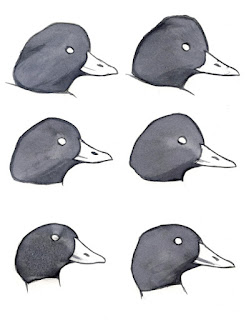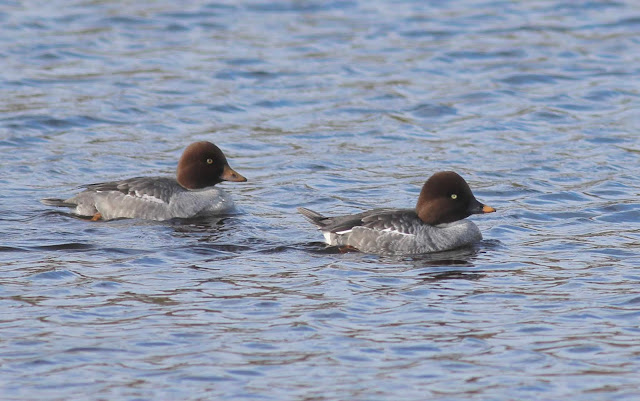First let me explain the two sources I am relying on the most, Sibley has a link on "Distinguishing female Barrow's and Common Goldeneyes" here: http://www.sibleyguides.com/2010/01/distinguishing-female-barrows-and-common-goldeneyes/
Also, I am referring to this cool link from the Canadian government as a ID guide for hunters here: https://www.canada.ca/en
I am also going to paste in some graphics from these web links. In fact first let's get the most problematic issue out of the way first. Sibley points to the bill as the most important factor and he says the structure and shape of the bill is the most important not the color.
Barrow's on left side and Common on right with dry and relaxed birds on top and alert/wet birds on bottom. One quote I thought was particularly important from this article was this:
"Birders often emphasize the shorter bill of Barrow’s as a field mark, but this is a vague and overly simplistic description of the differences in bill shape and size. There is only a small average difference in bill size: Common averages longer-billed, Barrow’s shorter. Pyle (2008) gives measurements for exposed culmen of females as 31-37 mm in Common, 29-33 mm in Barrow’s. At the same time, the bill of Barrow’s averages slightly deeper than Common, so it is relatively quite a bit deeper and can appear stout and stubby. Even so, Fjeldsa (1993) plotted the ratio of bill length to bill depth and found that about half of the female goldeneyes in his sample fell in the zone of overlap. Even with calipers and a calculator, many goldeneyes can’t be identified by bill size."
So now with some of my pics.
In this pic it is tough to gauge size especially because the pinkish/yellow hue of the bird on the left gives the impression that the bill is bigger than the one on the Common Goldeneye (COGO) on the right. However, to my eye, the shape of the bill fits the profile of the Sibley picture for an alert/wet Barrow's which this bird was. This bird was actively diving while it seemed the COGO was not diving as much so probably had drier feathers and to be honest looked more at ease. What I see is a base of the bill on the top that is quite angular and then on the bottom has a broader look than the slim tipped COGO's bill. To me the potential BAGO's bill is stubbier even if not smaller.
Another field mark mentioned in both guides is the slope of the forehead but again Sibley cautions us:
"These classic head shapes are seen on relaxed birds with head feathers more or less erect. Active, diving, or alert birds show quite different head shapes. As the feathers are compressed against the head the tall forehead of Barrow’s and tall crown of Common disappear, both species have a smoothly rounded forehead and long sloping crown. The longer mane of Barrow’s is still evident, as is a small angle at the rear crown of Common."
To make my point, here are some pics of the potential BAGO that shows the sloped look that naysayers are saying my bird doesn't have:
Granted the bird is looking towards the camera, so here is another photo below with a good comparison with the COGO.
If the naysayers saw this photo alone I probably would not have such a hard time making my case. In this photo the potential BAGO's forehead is prominent and even the bill is stubbier looking than the COGO's.
Let's move to another ID mark flagged by Sibley, the nail on the bill.
The "nail" for BAGOs tends to be fatter and the tip of the bill comes to more of a point than that of a COGO.
Here is a photo of the potential BAGO's bill tip and nail. Seems pretty big to me, but hard to say for sure.
A similar angle on the COGO here, and to me it seems the shadow caused by the nail is thinner but it is admittedly a bit difficult to tell. I think some of the other birders might have better pics to share for this field mark.
Since I am reading Sibley's comments in order, here is another quote that I think is important to remember:
"Female Common Goldeneyes rarely but regularly have mostly yellow bills like Barrow’s. I have identified only three or four personally in the northeastern US, and one in California, but they are apparently more frequent elsewhere. Reportedly “several per year…one in several thousand” Commons in Minnesota (Karl Bardon, email to ID-Frontiers); 12-14 individuals in 14 years observation in Colorado (Tony Leukering, email to ID-Frontiers); 1-2 per winter in southern Maine (Derek Lovitch, pers. comm.); and they are seen regularly in eastern Ontario with at least several every winter (Di Labio et al. 1997; email). On the other hand, Shai Mitra (in email) reports experience similar to mine – that in the Long Island, NY to Rhode Island region yellow-billed female Common Goldeneyes are rarer than female Barrow’s."
So even if the naysayers are correct and this is a COGO, the odds are that it is more rare than a BAGO.
Ok, now on to head color:
"Adult female Barrow’s has a darker, richer, more saturated brown head color, compared to a paler, “drier”, more orange-brown color on Common. The difference can be very subtle, and depends on lighting and angle of view, so this feature is most useful in direct comparison and must be confirmed by watching the bird at a variety of angles. Common may also have the tips of the longest nape feathers paler, appearing “frosted”, unlike the solidly dark Barrow’s (needs confirmation)."
This is where I think my bird is showing some definite BAGO traits.To me the potential BAGO has a definite chestnut richness compared to the COGO. The eye color mark (richer gold on BAGO) is also evident in this photo.
This photo too.
And here.... I can understand if someone were to say that this is not reliable based on the angle of the head but I am seeing this in almost all of the shots I have.. Consistently the possible BAGO has more chestnut or bay coloring if we are talking in horse color language. Reddish tones....
This photo with the potential BAGO on the right is also interesting because not only in the color have the reddish tones, but the "mane" is more evident which is yet another BAGO field mark.
The angles are uneven on this one but it shows the huge difference in the color tones. Potential BAGO in the foreground. I don't have any photos where the COGO shows these rich red tones so I don't think it is fair to discount this field mark.
Last comment from Sibley's link is in regards to white in the wings.
"Barrow’s has, on average, less white in the wings than Common. This is most easily determined by counting the number of white secondaries – 7 or more on Common, and only 6 or fewer on Barrow’s. In the field, the variation within each species, and the shifting appearance as the wing spreads and folds, makes this feature essentially useless. Even in photographs it is of very limited value. Compare the photos shown in Carney, 1992."
So with this statement in mind, let's switch to the Canadian website photo ID panel for wing patterns.
What I like about this ID card is more in relation to the number of white wing panels, not so much the number of feathers or the amount of white within each panel since Sibley clearly thinks it is not too important.
For an adult female, which I am fairly sure my bird is, the middle left picture is what I was looking for in confirmation. Unfortunately yesterday I was not successful in getting an overhead shot of the wing only the under wing.
The COGO record shot.
The potential BAGO shot... This did not help me much and I can see what Sibley is saying. However, I do want to point out the stubby appearance of the bill and sloped appearance of the forehead in this shot.
Another birder that was there (George S) was nice enough to let me use this next photo which is a back of the camera shot from his camera.
Especially interesting which is not mentioned in the references but is evident in the picture from the Canadian website is the half dark secondary closest to the body of the bird which comes across prominently in George's photo. Very curious that this half dark feather is not in the COGO photo.
It was nagging me yesterday that I did not have any dorsal wing shots of the coverts. It was especially nagging me because in the picture on the Canadian website, the BAGO adult female wing picture has two white secondary panels and a mottled looking covert which to me looked definitive compared to the COGO adult female wing pic that has three distinct white panels. So today I took a lunch break and somehow lucked into these pictures within 10 minutes of getting there!
Mottled coverts with two white wing panels!
Also look at that "mane"..... Like a freaking lion you haters...
I could be mistaken but I think I also heard her roar.....
A dude on the Facebook ID page marked up my photo with numbers on the feathers.
But I think this is difficult because you get different numbers based on whether you count the inner panel or the outer, and also the one feather is half black. So 6 and a half? The rule is supposed to be 6 and under for BAGO and 7 and over for COGO but from the guides it does not specify inner or outer panel. If you count only fully white feathers, this is falling in BAGO territory. However, per Sibley I am not worried about the number of feathers.
I am going to end with my final picture from today's lunch.. Although the light was not ideal, I think it shows many of the marks pretty well...
Angular forehead with a stubby looking yellowish bill that has a big ass nail on it. Reddish tones to the lovely head and a nice rich golden eye color.
I know I am working hard to make this happen and I also know that the bird police are probably going to cry hybrid, but I implore the detractors to study the points I have laid out before they judge this beauty too hastily. I am all for the intermixing of races, but in this case let the bird gods please confirm this is a pure BAGO!























What would James Bond have said?
ReplyDeleteShaken not stirred?
ReplyDelete